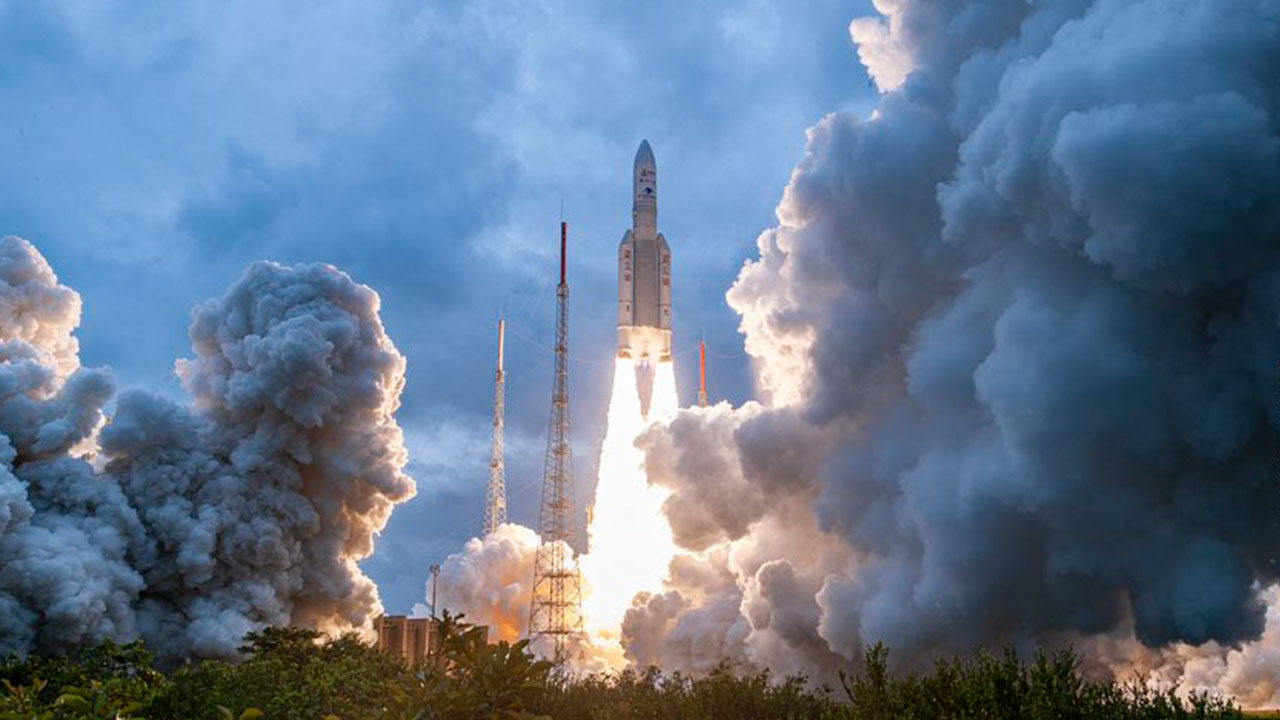ARIANE 5 GOES DOWN IN HISTORY WITH SUCCESSFUL LAUNCH OF WEBB
25.12.2021
The Ariane 5 launcher, operated by Arianespace on behalf of the European Space Agency (ESA), has successfully injected NASA’s Webb Space Telescope into its transfer orbit towards its final position at the second Lagrange point (L2). Carrying out its final mission of the year, the Ariane 5 rocket once again proved its exceptional reliability, this time for the benefit of research and space exploration. After a journey lasting 29 days, the most powerful space telescope ever built will be placed into orbit around the Lagrange 2 point so that it can observe galaxies, planets, stars and even nebulae and help us to unravel the secrets of the Universe.

On Saturday, December 25, 2021 at 9:20 am local time, an Ariane 5 rocket lifted off from the Guiana Space Center, Europe’s Spaceport in Kourou, French Guiana (South America), injecting the Webb Space Telescope, developed by NASA in partnership with ESA and the Canadian Space Agency (CSA), into its transfer orbit. The telescope was successfully separated from the launcher 27 minutes after liftoff.
The telescope now embarks on a voyage lasting 29 days to reach the second Lagrange point.
- On the third day, the heat shield will begin to deploy. On the eleventh day, the secondary mirror will begin positioning.
- Between the 13th and 14th day, the primary mirror, comprising 18 hexagonal segments and measuring 6.5 meters in diameter, will be assembled.
- The telescope is slated to arrive at its final destination, 1.5 million kilometers from Earth, approximately 29 days after launch.
The space agencies of the United States (NASA), Europe (ESA) and Canada (CSA) teamed up to develop this telescope. Europe played an important role in this mission, with ESA providing the launch onboard Ariane 5, as well as the Nirspec spectrometer built by Airbus. The astrophysics department of the Saclay-based CEA (French Alternative Energies and Atomic Energy Commission) and the Paris Observatory designed the MIRI camera. This is the most ambitious telescope ever sent into space.
Intended as the successor to the Hubble Space Telescope, the Webb Space Telescope will be 100 times more powerful. It will incorporate improved and different technologies to capture 70% more light. Because of these innovations, astronomers will be able to make unprecedented observations that show the first stars and galaxies to be formed after the Big Bang.
The engineers from ArianeGroup, Arianespace and their European industrial partners developed specific solutions for this mission to ensure the perfect compatibility between Ariane 5 and its passenger.
- A special adapter for the satellite was designed and built in compliance with the available space under the fairing: the telescope measures 10.5 meters high and nearly 4.5 meters wide under the fairing, versus 21 x 14 meters once deployed.
- The fairing underwent a special cleaning to ensure that no dust could come in contact with the telescope and its essential mirrors.
- Pistons were placed near the purge vents in the fairing to force their opening and reduce as much as possible any pressure differential between the inside of the fairing where the telescope is located and the vacuum of space;
- To protect the telescope’s fragile components from any undesirable thermal effects, the flight software has been set up so that Ariane 5 performed a specific roll maneuver to control its exposure to the Sun once the fairing was jettisoned.
- Following the separation of the telescope from the upper stage of the launcher, in order to avoid any risk of possible collision between the two, a specific maneuver was carried out to move the stage away after the end of its propulsion phase using its propellants and residual gases.
- By drawing on the combined experience of more than 100 Ariane 5 missions, Arianespace provided an exceptionally precise orbital injection towards the second Lagrange point.
ArianeGroup is prime contractor for Ariane 5 and Ariane 6, in charge of development and production, at the head of a vast industrial network of more than 600 companies, including 350 small and medium-size enterprises (SME). ArianeGroup coordinates all industrial activities concerning Ariane 5, from initial design studies and performance upgrades, to production and the supply of the data or software needed for each mission. Its responsibilities include various components, subassemblies and structures, the production of propulsion systems, stage integration and then integration of the launcher itself at the Guiana Space Center. ArianeGroup delivers a flighworthy launcher on the launch pad to its subsidiary Arianespace, which oversees flight operations for its customers, starting with liftoff.
Ariane 5 is a European Space Agency (ESA) program, carried out in collaboration between industry and public institutions. Marketed and operated by Arianespace, Ariane 5 launches are carried out at the Guiana Space Center (CSG) in Kourou, French Guiana, with support from the French space agency CNES (Centre national d’études spatiales).